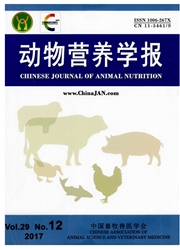

 中文摘要:
中文摘要:
本文旨在研究日粮淀粉来源对生长猪氮代谢和血液中部分生化指标的影响。试验选择17头体重(21.09±0.72)kg的杜×长×大三元杂交阉公猪,以玉米、早籼稻糙米、糯米和抗性淀粉作为淀粉来源,配合4个等氮、等能、等淀粉试验日粮和1个无氮日粮,进行1个按5×5拉丁方设计的氮代谢试验和1个为期8d的单因子饲养试验。结果表明,抗性淀粉组蛋白质表观和真消化率均最低,表观消化率分别比玉米组、糯米组、糙米组低9.28%、11.31%和11.05%(P〈0.05),真消化率分别低8.79%、10.80%和10.50%(P〈0.05);蛋白质沉积率以玉米组最高,分别比抗性淀粉、糯米和糙米日粮组高25.98%(P〈0.05)、1.32%(P〉0.05)和1.37%(P〉0.05)。血液生化指标分析结果显示,抗性淀粉组试验猪的血液中葡萄糖、胰岛素浓度及胰岛素/血糖变化比较平稳,其他各组采食后升高幅度较大,1h后达到高峰;其中糯米组采食后1h血液中葡萄糖、胰岛素含量及胰岛素/血糖最高,分别为1.21mg/mL、52.35μU/mL和43.27μU/mg,显著高于其他各组(P〈0.05)。由结果可知,日粮淀粉来源影响生长猪氮代谢和血液部分生化指标,抗性淀粉组的血糖和胰岛素变化幅度较小,蛋白质的沉积率也较低。
 英文摘要:
英文摘要:
The objective of this experiment was to study the effects of dietary starch sources on nitrogen metabolism and part blood biochemical indices in growing swine. One nitrogen balance trial by 5 × 5 Latin square design and the other feeding trial for 8 days using 17 castrated Duroc × Landrance x Yolkshire barrows with an average weight of (21.09 ± 0.72) kg were conducted, and 4 iso-nitrogen, iso-energy and iso-starch diet were formulated using maize, brown rice, stick rice and resistant starch as starch sources, respectively, as well as a nitrogen free diet was formulated to determinate endogenous nitrogen losses. The results showed that the lowest apparent and true digestibility of crude protein were found in resistant starch group, and apparent digestibility of crude protein in resistant starch group were 9.28%, 1l. 31% and 11.05% (P〈0.05) lower than those in maize, stick rice and brown rice group, while, true digestibility of crude protein in resistant starch group were 8.79%, 10.80% and 10.50% (P〈0.05) lower than those in maize, stick rice and brown rice group. The highest nitrogen retention rate was found in maize group, which was 25.98% (P〈0.05), 1.32% (P〈0.05) and 1.37% (P〈0.05) higher than that in resistant starch group, stick rice group and brown rice group, respectively. The results of blood biochemical indices analysis showed that, the change of post-prandial blood glucose, insulin concentration and insulin/glucose in resistant starch group were stable, while those in other groups had larger fluctuation, which reached the pinnacle after postprandial 1 h, and stick rice group had the highest blood glucose, insulin concentration and insulin/glucose after post-prandial 1 h, which were significantly higher than other groups (P〈0.05), and these indices in turn were 1.21 mg/mL, 52.35μU/mL and 43.27 μU/mg, respectively. In conclusion, dietary starch sources affected nitrogen metabolism and blood biochemical indices. Fluctuation of blood glucose and insulin in resist
 同期刊论文项目
同期刊论文项目
 同项目期刊论文
同项目期刊论文
 期刊信息
期刊信息
